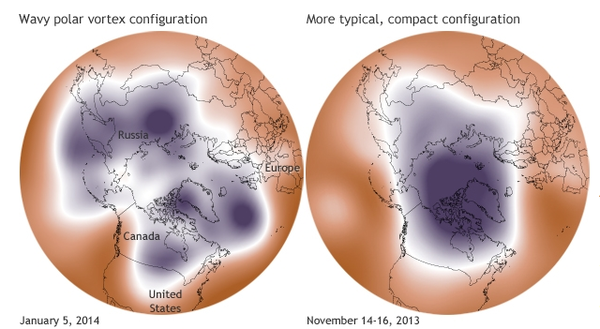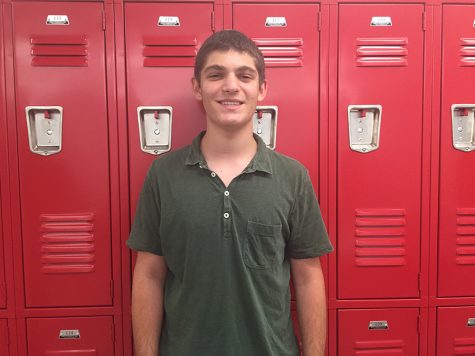If the earth is warming, why is it freezing out?
Scientists say global warming may actually be cause of recent cold

POLAR: The globe on the right shows the “polar vortex” in its normal position over the far north, whereas the one on the left shows how far it had spread on Jan. 10 of this year.
January 14, 2014
Jumping out of the car 20 feet from the door of school last month, there was one thought in many students’ heads: run inside Recently, the U.S. has experienced a series of record-breaking cold snaps. Even Los Angeles has had many mornings in the 40s, 10 to 15 degrees below normal for this time of year.
Last week, the polar vortex — a large pocket of cold air that usually sits over the Arctic — dropped down into the United States, bringing record-breaking cold to more than 20 states, according to news reports. In Manhattan, a 118-year record of six degrees Fahrenheit was broken Jan. 7 in Central Park.
Things got so cold in the Midwest that the polar bear at Chicago’s Lincoln Park Zoo had to be kept inside. Things got so cold that public schools in Minnesota were shut down, the mayor of Indianapolis banned driving, and the National Weather Service warned that the wind chill could be fatal to people outside for more than 10 minutes without sufficient clothing.
People are wondering: what about global warming? Aren’t temperatures supposed to be rising, and ice melting?
Shalhevet chemistry teacher Dr. Jay Smallwood said that this is a huge misunderstanding, and that there will still be cold weather in the world for a long time — even as global warming continues.
“Global warming refers to the average temperatures of the whole earth that are rising year by year,” said Dr. Smallwood in an interview. “It is an effect that occurs over many, many years. Global warming doesn’t mean that everywhere will get hot and there will never be cold weather.”
Though cold weather is being felt everywhere across the U.S., Dr. Smallwood explains that it is still “local” and happening over a short period of time compared to the time it takes for the effects of global warming to take place.
But also, even in the long run, global warming might make both Europe and North America colder —not hotter — than they currently are.
According to Dr. Smallwood, an ocean current from the Arctic normally comes down into the Atlantic and circulates water in the Atlantic Ocean, sending a current from the Gulf of Mexico eastward toward Europe and keeping that continent warmer than somewhere that far north would otherwise be.
However, when the polar ice caps melt as a result of global warming, an immense amount of cold, fresh water disturbing that current may cut off the circulation that normally happens and, as a result, make Europe colder than it is now.
That does not explain what’s been happening in the U.S., since North America is not affected by that current. But it’s possible that America, too, might cool due to global warming.
Rutgers University climate scientist Jennifer A. Francis attributes the strange, cold weather to the warming Arctic air caused by man-made greenhouse gasses. This warm air has caused a change in the jet stream by reducing the difference in temperature between warm and cold parts of the Northern Hemisphere.
In a 2012 article in The Washington Post, Prof. Francis said melting polar ice caps had slowed the jet stream and made it possible for colder air — including the polar vortex — to slip southward into the U.S.
“We can’t say that these extremes are because of climate change, but we can say that this type of pattern is becoming more likely because of it,” said Prof. Francis in a recent interview with The Hill, a Washington, D.C., news source.
Meanwhile, some parts of the world are definitely getting warmer, including Australia. Last summer was the hottest summer ever for them, with temperatures of over 125 degrees fahrenheit in some places.
And in Fairbanks, Alaska — where normal temperatures for this time of year are below zero — temperatures rose into the 20s, warmer than many locations in Georgia and Alabama, due to the polar vortex moving south.
Dr. Smallwood says the most important thing to remember about global warming is that it is very slow and gradual, and warm and cold seasons will persist.
For now, Los Angeles has been spared the worst of the weather in the U.S., just as it usually is. Few Americans — human or polar bear — would consider December temperatures in the 40s to be a “cold snap.”
Which still doesn’t mean morning carpool lately in Los Angeles has felt like a walk in the park.
This story won a National Award for News Writing in the 2014 International Writing and Photo Contest of the Quill and Scroll Society, judged by the American Society of News Editors.













